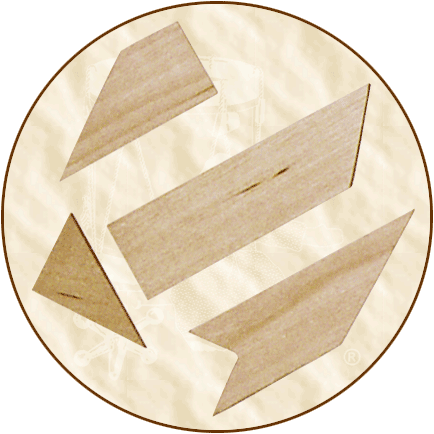.
Continued from product description on
Classic Toys & Puzzles' Page
Five...
Historical
Background: The T Puzzle was first used in advertising
in the early 1900s. The oldest puzzle that we know of is the
one that was included with a box of White Rose Ceylon Tea distributed
by Seeman Brothers of New York in 1903. The puzzle has four parts
and has printed on the longest part, "Arrange these four
pieces of cardboard so as to form a perfect T. White Rose Ceylon
is a perfect Tea." The puzzle is blue and white with gold
borders. One piece depicts a cup of steaming tea. Below are three
of the actual pieces from this puzzle. A reference to the T-puzzle
appears in "Carpentry & Mechanics for Boys," published
by A. Neely Hall in 1918. Hall's description states, "The
T-Puzzle, a famous old puzzle is more difficult to assemble than
it looks." Hall gives a full-size pattern for making the
puzzle with a scroll saw and the solution in his book.

Other merchants picked up on this idea of advertising with
letter-dissection puzzles, and T Puzzles were eventually used
by Anderson-Pitt Corporation of Kansas City, who sold electric
heaters and by Armour & Co. of Chicago, who sold dry sausage.
Known as "The Teaser Puzzle" or "The Tormentor,"
each of Armour's four pieces was printed with advertising messages.
They did not enclose the solution. This message was stated on
the puzzle package:
The Teaser, Please accept this interesting little puzzle with
our compliments. You will find it a real test to fit the four
pieces enclosed in this envelope together to form this perfect
letter 'T.' If you fail to solve it, ask your dealer for the
solution.
The H Puzzle was used by Hathaway Bread and featured six pieces
wrapped in a paper bag which stated:
The new H Puzzle, only six pieces, can you do it, lay the
six pieces together to form a letter 'H.' 'H' stands for Hathaway's,
the bread that pleases everybody.
A French T Puzzle known as "L'été"
was created around 1920 by N.K. Atlas in Paris. His version was
not intended to be an "advertisement puzzle" and was
sold in a cardboard box.
The T Puzzle is actually based on the six-piece "Ivory
Cross Puzzle" that originated in China. The Ivory Cross
Puzzle, or "Latin Cross," which was also cut diagonally
into five pieces, was published in "Magicians' Own Book"
in 1857. The five-piece cross puzzle can also be made into a
rectangle, but the four pieces of the T puzzle can only make
the letter "T."
Our T Puzzle (2102) is fun for children of all ages and is
still used as an advertising tool by many businesses today, particularly
at trade shows!
Fun
Fact: Tea was first discovered in China in 2737 B.C.
Fun
Fact: "Afternoon tea" was introduced in England
around 1840 by Anna, the Duchess of Bedford.
Fun
Fact: The first tea bags were introduced in 1904 by Thomas
Sullivan, a New York tea and coffee shop merchant. Until this
time, all tea was loose.
Fun
Fact: Ice tea was created at the St. Louis World's Fair
in 1904 by English tea concessionaire Richard Blechynden.
Fun
Fact: The White Rose Company introduced the world's first
instant ice tea, White Rose Redi-Tea, in 1953.













